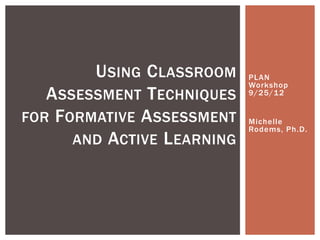
Using Classroom Assessment Techniques
- 1. U SING C LASSROOM PLAN Workshop A SSESSMENT T ECHNIQUES 9/25/12 FOR FORMATIVE A SSESSMENT Michelle Rodems, Ph.D. AND ACTIVE L EARNING
- 2. TRADITIONAL METHODS OF INSTRUCTION Provide/deliver instruction, transfer knowledge Improve the quality of instruction Criteria: inputs, resources, curriculum development, enrollment, quality of instruction Structures: time constant, learning varies; one -teacher, one-classroom; covering materials; end -of-course assessment Learning: “out there”; cumulative and linear; teacher - centered and controlled; environment competitive and individualistic; talent and ability rare Roles: Faculty are lecturers, faculty and students in isolation
- 3. CAT: PROS & CONS
- 4. CATS
- 5. CLASSROOM ASSESSMENT TECHNIQUES CATS Classroom Assessment is an approach designed to help teachers find out what students are learning in the classroom and how well they are learning it.
- 6. CHARACTERISTICS Learner-Centered Teacher-Directed Mutually Beneficial Formative Context-Specific Ongoing Rooted in Good Teaching Practice
- 7. ASSESSMENT Summative Formative “Assessment of “Assessment for Learning” Learning” Occurs after Occurs during instruction instruction Measure level of Gathers feedback to success or guide improvement proficiency achieved Generally low -stakes Generally results in grade
- 9. “HOW TO”
- 10. 3 STEP PROCESS Planning Start small Implementing Prepare students Be clear Read Responding “Close the feedback loop” Talk to students, inform them of adjustments
- 11. Step 2: Focus on an assessable goal or question CLASSROOM Step 3: Plan a Step 1: Choose the classroom ASSESSMENT assessment project focus class focused on that goal or question PROJECT CYCLE Step 9: Evaluate this Planning Step 4: Teaching the target lesson related project’s effect(s) on to that goal or teaching and learning question Step 8: Communicate Step 5: Assess results; try out student learning: response collect feedback data Step 7: Interpret the results and formulate Step 6: Analyze an appropriate student feedback responds to improve learning
- 13. BLOOM’S TAXONOMY
- 14. CAT: NOTE-CARD NEXT STEPS 5-10 Minutes Select one CAT from list of examples Apply to course Work through project cycle 5-10 Minutes Share with group
- 15. CHECKLIST
- 16. LESSONS LEARNED Faculty adapt Classroom Assessment Techniques in creative ways Classroom Assessment feedback challenges teachers’ assumptions Teachers respond to feedback in various ways Classroom Assessment increases active involvement in learning Classroom Assessment promotes metacognitive development Classroom Assessment increased cooperation and a sense of the classroom as a “learning community” Classroom Assessment increases student satisfaction Classroom Assessment may improve course completion rates Does it increase student learning?
- 17. CAT: MUDDIEST POINT What is still confusing? Where do you still need more information? Take one minute and respond to this question. Share with the group.
- 18. KEEP IN MIND . . . Start with assessable goals. Focus on alterable variables. Build in success. Start small. Get students actively involved. Set limits on the time and effort you will invest. Be flexible and willing to change. Work with other teachers who share your interests. Remember that students must first learn to give useful feedback – and then must practice doing so. Enjoy experimentation and risk-taking, not just success.
- 19. Picture Credits http://www.proconlists.com/list/humor/making -pro-con- lists/1494 http://extollereblog.tumblr.com / http://www.our40th.com/get -in-touch/ http://meandmylaptop.weebly.com/2/post/2011/4/blooms - taxonomy.html Angelo, T. A ., & Cross, K. P. (1993). Classroom Assessment Techniques: A handbook for college teachers (2 nd ed.). San Francisco, CA: Jossey -Bass.
Hinweis der Redaktion
- Introductions
- CAT: Pros & Cons Grid
- Learner-CenteredHelps students take responsibility for their learning. Gives students information about their learning.Teacher-Directed“Wise and effective use of judgment and knowledge” – what to assess, how to assess, how to respond. Mutually BeneficialRequires active participation of students. Can increase motivation. “What are the essential skills and knowledge I am trying to teach?”FormativeContext-SpecificResponds to the particular needs and characteristics of the teachers, students, and disciplines.OngoingFeedback loop. Rooted in Good Teaching PracticeFeedback early and often.“An attempt to build on existing good practice by making it more systematic, more flexible, and more effective.”Can become self-assessment
- In one sentence, summarize your understanding of CATs
- Class going well. Minimize risks and variability.
- Note-Card Next Steps
